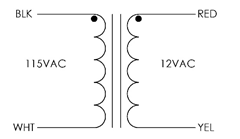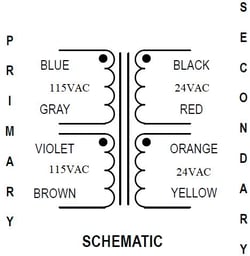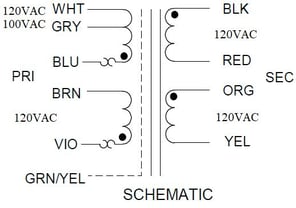What is an Autotransformer?
Autotransformers feature a single winding wound onto a laminated core. They're similar to two-winding transformers, but their differences lie in the ways that the primary and secondary winding are interrelated. There are two varieties of autotransformers which may be differentiated by their construction.
- In the first type, the transformer relies on continuous winding and taps are brought out at convenient points based on the desired secondary voltage.
- In the other style of autotransformer, two or more distinct coils are electrically connected and form a continuous winding.
The Advantages of Autotransformers
Autotransformers present several advantages over traditional transformers, .jpg?width=300&name=N-1X%20Autotransformer%20(1).jpg) including:
including:
- Lower cost
- Improved regulation
- Lower losses compared to standard transformers of the same rating
Autotransformers also save on copper when compared to two-winding transformers:
- The weight of copper utilized for transformers is proportional to the length and area of a cross section of the conductor
- Conductor length is proportional to the number of turns
The Disadvantages of Autotransformers
Despite these benefits, autotransformers are not without limitations. Some negative aspects of autotransformers include:
- Only useful in limited applications which require a slight variation of output voltage from input voltage
- If used to supply low voltage from a high voltage source, the full primary voltage may come across the terminal in the event of a break in the secondary winding. This poses a risk to operators and equipment.
Triad Magnetics' Autotransformers
Triad Magnetics offers autotransformers in step-up and step-down single winding models.
- With step-up models the primary coil will only be a percentage of the full winding.
- In step-down models, the secondary coil is a percentage of the full winding.
Any of our transformers can be converted to autotransformers by connecting all of the windings in series with each other. With fourteen different autotransformer power transformers to choose from, we have a model well suited to your needs. One of these models is a universal isolation/autotransformer/voltage control model which can operate at an output wattage rating of 4,000 output watts.
Creating Your Own Autotransformer Using Off-the-Shelf Power Transformers
All of Triad’s off-the-shelf transformers can be wired in a series or parallel combination to create an autotransformer. This is achieved by combining the primary of the transformer with the secondary to create a step-up or step-down transformer.
Before going into examples on how to wire an off-the-shelf transformer into an autotransformer, we must know how windings must be wired and why they must be wired in that manner. One end of the winding will have a dot indicating the start of the winding and the other end of the winding will be the finish.
The windings must be wired in phase. Phasing is important because it determines the direction in which the current flows. If the windings are wired out of phase, the currents from each winding would oppose each other causing a short within the transformer.
Take this schematic, for example:

Each winding has its own pair of leads that are specified with different lead colors. The leads on the left represent the primary winding of the transformer and the leads on the right represent the secondary winding of the transformer. By wiring the primary and secondary windings in series, the transformer would be considered an autotransformer.
To wire the windings in series, the WHT lead would have to be wired to the RED lead. This will result in a single winding with the WHT/RED connection being a center tap and the BLK and YEL leads being the full winding. Wiring the two windings in series will cause the total voltage across the full winding to be the sum of the voltages of each winding.
For example, the primary winding is rated for 115VAC, whereas the secondary winding is rated for 12VAC. Wiring the two windings in series will cause the voltage of the full winding to be 127VAC. When making this type of connection, the transformer loses its isolation properties.
Below is another real-world example of making an autotransformer from a 4-winding transformer:

This can be done for applications that require a transformer with a 277VAC input. The schematic above represents the VPT48-2080. This transformer has two windings on the primary and two windings on the secondary. The four windings can be wired in series to make an autotransformer with a 278VAC output.
This can be done by wiring the following leads together: GRAY to VIOLET, BROWN to BLACK and RED to ORANGE.
Each series connection will accumulate the voltage for each winding. Wiring the 4 windings in series will sum up the voltages as follows: 115 + 115 + 24 + 24 = 278VAC.
For this example, we will make a 4-winding transformer into an autotransformer for applications that require a transformer with a 480VAC input. Below is the schematic for the medical grade toroidal transformer, VPM240-1040:

The 4 windings can be combined in series to make an autotransformer with a 480VAC output. This can be done by wiring the following leads together: BLU to BRN, VIO to RED and BLK to YEL. Similar to the VPT48-2080, the voltages for each winding accumulate as follows: 120 + 120 + 120 + 120 = 480VAC.
For this final example, we will use the same schematic as the VPM240-1040. In this example, the primary windings will be wired in parallel, the secondaries will be wired in parallel and the two resulting windings will be wired in series. When windings are put in series, the voltages are added together and that sum is the voltage capability of the two wired windings. For windings have the same current rating, the current capability doubles when they are wired in parallel.
The different connections for parallel and series are as follows:
· Primaries in Parallel: BLU to VIO and WHT to BRN, WHT/BRN and BLU/VIO is the full winding rated for 120VAC.
· Secondaries in Parallel: BLK to ORG and RED to YEL, BLK/ORG and RED/YEL is the full winding rated for 120VAC.
· New Primary & New Secondary in Series: BLU/VIO to RED/YEL, WHT/BRN and BLK/ORG is the full winding rated for 240VAC.
Making these connections doubles the power rating of the transformer due to the higher current and voltage capabilities. The autotransformer made from the VPM240-1040 will now have the capability for a 240VAC input and a current of 2.08A. The product of the voltage and the current is 500VA as opposed to 250VA as an isolation transformer.
Depending on the difference between the input voltage and the output voltage, the power rating will be affected. For instance, if the difference is higher, the power output will be lower and vice versa.
Safety Considerations
The main safety consideration when making an autotransformer from an isolation transformer is the loss of isolation. The isolation is lost due to the direct connections made when combining windings in series or in parallel. The output of the transformer would then be referenced to ground and making contact with the connection can be harmful or even fatal.
When making an autotransformer from an isolation transformer with multiple windings, it is important to take into account the current rating of the windings. We must be mindful of the current ratings for each winding to ensure that the transformer does not heat up excessively, or, in some extreme cases, melt the magnet wire insulation, causing a short. The current rating for the autotransformer should be limited by the lowest rated current winding.
Transformer Solutions from Triad Magnetics
Triad Magnetics has more than 1,000 part numbers for customers to select from and we offer a pioneering design process that fosters innovation and growth. These factors, along with world-class manufacturing and steadfast commitment to quality and reliability, position us as the number one choice for all of your transformer needs.
Interested in learning more about transformers from Triad Magnetics? Contact us today or request a quote for further information.






